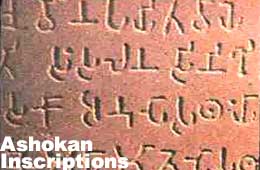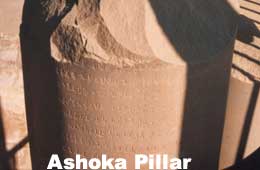| India Profile » Monuments and Temples in India » Ashokan Inscriptions | |
Ashokan Inscriptions | |
 | |
>
 Ashoka (d.273-236BC) was the most successful and powerful kings of the Mauryan Empire. In the 19th century AD, a large number of Ashokan edicts came into light from in India, Nepal, Pakistan and Afghanistan. These edicts are inscribed on the rocks and the pillars. These edicts proclaim about the reforms in Ashoka's policies and promulgation of his advice to his subjects. After committing frightful atrocities in the Kalinga war, Ashoka later repented of the blood bath and converted his religion. He openly declared his faith in the Three Jewels' of Buddhism in the 'Bhabru Edict'. He also went on a pilgrimage of the holy places associated with the Buddha. Ashoka had engraved his Dharma, i.e., the 'Law of Piety' on the rocks and pillars in order to spread Buddhism. It contained the fundamental principles of mastery of the sense, purity of thought, gratitude, steadfastness of devotion, kindness, charity, purity, truthfulness, service, support and reverence. The Ashoka's edicts carved on the rocks have been discovered at Kalsi. Sopara, Girnar, Dhauli, Jaugada, Maski and Yeraguddi in India and at Shahbaz Garha and Mansehra in the NWFP. Ashoka's edicts are mainly concerned with the reforms he instituted and the moral principles he recommended in his attempt to build a fair and humane society. They are unable to give us much information about his life. The inscriptions on rocks reveal the steps taken by Ashoka for the propagation of his "Law of Piety". In 1837 AD, James Princep succeeded in deciphering an ancient inscription on a large stone pillar in Delhi. The 14 edicts enunciate the leading principles of the Buddhism but fail to mention about the life of the Buddha nor of his teachings in particular. Even the name of Ashoka is not mentioned on a single edict. The name Ashoka occurs in the minor rock edicts at Maski and Gujarat in India. The titles of the emperor, Devanampriya meaning 'Beloved of the Gods' and Priyadarsin meaning 'One of the Amiable Look' appear again and again in the edicts at Shahbaz Garha and other places in India. Gradually the scholars realized that the King Priyadasi of the edicts might be the King Ashoka so often praised in Buddhist legends. However, it was not until 1915 that the identification was confirmed, when another edict actually mentioning the name Ashoka was discovered.
Ashoka's edicts are found scattered in more than thirty places throughout India, Nepal, Pakistan and Afghanistan. Most of them are written in Brahmi script. The Magadhi language is used in the edicts in the eastern part of the sub-continent, which is probably the official language of Ashoka's court. The language in the edicts found in the western part of India is nearer to Sanskrit. One bilingual edict in Afghanistan is written in Aramaic and Greek. Ashoka's edicts have survived over the period of centuries is because they are written on the rocks and stone pillars. There is every possibility that there must have been many more edicts, although only ten with inscriptions survive today. The average height of these edicts is between 40 and 50 ft and weighs up to fifty tons each. All the pillars were quarried at Chunar, just south of Varanasi and were dragged to the places where they were erected. Each pillar was originally capped by a capital, of a roaring lion, a noble bull or a spirited horse, and the few capitals that survive are widely recognized as masterpieces of Indian art. Both the pillars and the capitals exhibit a remarkable mirror-like polish that was the unique feature of the Mauryan art and has survived despite centuries of exposure to the elements. The location of the rock edicts is governed by the availability of suitable rocks. but the edicts on pillars are found in places, which have significant association with the life of Buddha or are en route to major pilgrimage centers so that as many people as possible can read these edicts. The Lumbini pillar marks the Buddha's birthplace, while inscriptions on it commemorate Ashoka's pilgrimage to that place. Others are to be found in or near important population centers |
|
 |
